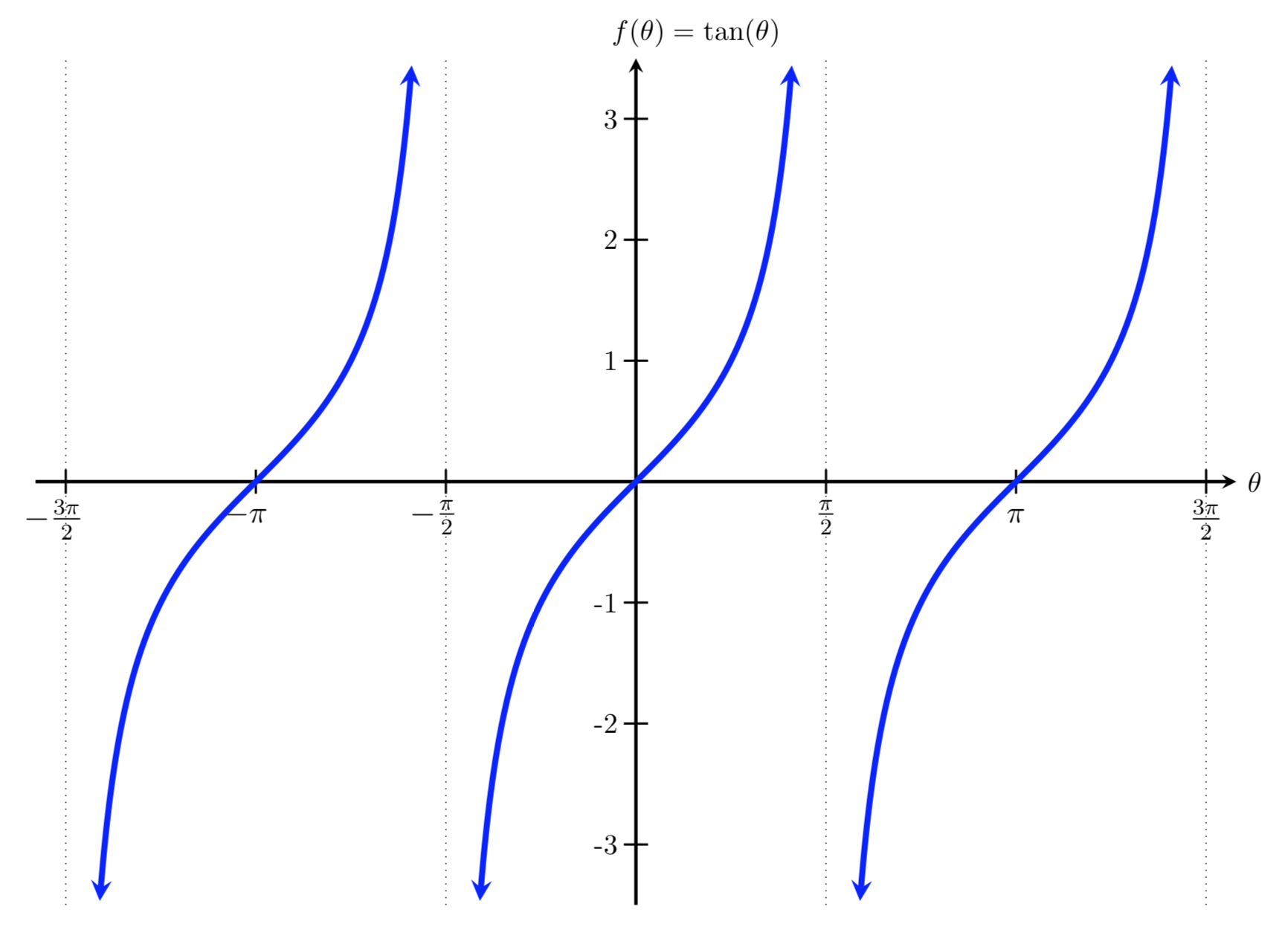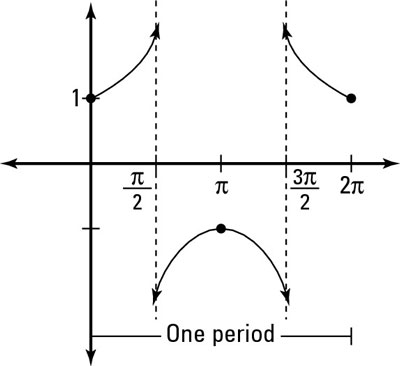7.9 KiB
Sine/Cosine
Given the above graph:
- At the origin,
sin(x) = 0andcos(x) = 1 - A full wavelength takes
2\pi
Manipulation
| Formula | Movement |
|---|---|
y = cos(x) - 1 |
Vertical shift down by 1 |
y = 2cos(x) |
Vertical stretch by a factor of 2 |
y = -cos(x) |
Flip over x axis |
y = cos(2x) |
Horizontal shrink by a factor of 2 |
Periodic Functions
A function is considered periodic if it repeats itself at even intervals, where each interval is a complete cycle, referred to as a period.
Sinusoidal Functions
A function that has the same shape as a sine or cosine wave is known as a sinusoidal function.
There are 4 general functions:
| $$A * sin(B*x - C) + D$$ | |
|---|---|
|
|
How to find the:
- Amplitude:
|A| - Period:
\frac{2\pi}{B} - Phase shift:
\frac{C}{|B|} - Vertical shift:
D
y = A * \sin(B(x-\frac{C}{B})) Tangent
y = tan(x)  To find relative points to create the above graph, you can use the unit circle:
To find relative points to create the above graph, you can use the unit circle:
If tan(x) = \frac{sin(x)}{cos(x}), then:
sin(0) = 0 |
cos(0) = 1 |
tan(0) = \frac{cos(0)}{sin(0)} = \frac{0}{1} =0 |
|---|---|---|
sin(\frac{\pi}{4}) = \frac{\sqrt{2}}{2} |
cos(\frac{\pi}{4}) = \frac{\sqrt{2}}{2} |
tan(\frac{\pi}{4}) = \frac{\sqrt{2}}{2}/\frac{\sqrt{2}}{2} = 1 |
sin(\frac{\pi}{2}) = 1 |
cos(\frac{\pi}{2}) = 0 |
tan(\frac{\pi}{2}) = \frac{1}{0} = DNF |
| Interpreting the above table: |
- When
x = 0,y = 0 - When
x = \frac{\pi}{4},y = 1 - When
x = \frac{\pi}{2}, there's an asymptote
Without any transformations applied, the period of tan(x) = \pi. Because tan is an odd function, tan(-x) = -tan(x).
Cotangent
y = cot(x) To find relative points to create the above graph, you can use the unit circle:
If cot(x) = \frac{cos(x)}{sin(x)}, then:
sin(0) = 0 |
cos(0) = 1 |
cot(0) = \frac{sin(0)}{cos(0)} = \frac{1}{0} = DNF |
|---|---|---|
sin(\frac{\pi}{4}) = \frac{\sqrt{2}}{2} |
cos(\frac{\pi}{4}) = \frac{\sqrt{2}}{2} |
cot(\frac{\pi}{4}) = \frac{\sqrt{2}}{2}/\frac{\sqrt{2}}{2} = 1 |
sin(\frac{\pi}{2}) = 1 |
cos(\frac{\pi}{2}) = 0 |
tan(\frac{\pi}{2}) = \frac{1}{0} = DNF |
Without any transformations applied, the period of cot(x) = \pi. Because cot is an odd function, cot(-x) = -cot(x).
Features of Tangent and Cotangent
Given the form y = A\tan(Bx - C) + D (the same applies for \cot)
- The stretching factor is
|A| - The period is
\frac{\pi}{|B|} - The domain of
tanis all ofx, wherex \ne \frac{C}{B} + \frac{\pi}{2} + {\pi}{|B|}k, wherekis an integer. (everywhere but the asymptotes) - The domain of
cotis all ofx, wherex \ne \frac{C}{B} + \frac{\pi}{|B|}k, wherekis an integer (everywhere but the asymptotes) - The range of both is
(-\infty, \infty) - The phase shift is
\frac{C}{B} - The vertical shift is
D
Secant
y = \sec(x) sec(x) = \frac{1}{\cos{x}} Because secant is the reciprocal of cosine, when \cos{x} = 0, then secant is undefined. $|\cos$| is never greater than 1, so secant is never less than 1 in absolute value. When the graph of cosine crosses the x axis, an asymptote for a matching graph of secant will appear there.
The general form of secant is:
y = A\sec(B{x} - C) + D A, B, C, and D will have similar meanings to the secant function as they did to the sine and cosine functions.
Cosecant
y = \csc(x) \csc(x) = \frac{1}{\sin(x)} Because cosecant is the reciprocal of sine, when \sin{x} = 0, then cosecant is undefined. $|\sin$| is never greater than 1, so secant is never less than 1 in absolute value. When the graph of sine crosses the x axis, an asymptote for a matching graph of cosecant will appear there.
The general form of cosecant is:
y = A\csc(B{x} - C) + D A, B, C, and D will have similar meanings to the cosecant function as they did to the sine and cosine functions.
Features of Secant and Cosecant
- The stretching factor is
|A| - The period is
\frac{2\pi}{|B|} - The domain of secant is all
x, wherex \ne \frac{C}{B} + \frac{\pi}{2} + \frac{\pi}{|B|}k, wherekis an integer. (Every half period + phase shift is where asymptotes appear) - The domain of cosecant is all
x, wherex \ne \frac{C}{B} + \frac{\pi}{|B|}k, wherekis an integer. - The range is
(\infty, -|A| +D]\cup [|A| + D], \infty) - The vertical asymptotes of secant occur at
x = \frac{C}{B} + \frac{\pi}{2} + \frac{\pi}{2} + \frac{\pi}{|B|}k, wherekis an integer. - The vertical asymptotes of cosecant occur at
x = \frac{C}{B} + \frac{\pi}{|B|}k, wherekis an integer. - The vertical shift is
D.
Inverse Functions
For any one to one function f(x) = y, a function f^{-1}(y) = x). A function is considered one-to-one if every input only has one output, and every output can only be created from a single input.
The inverse of a trig function is denoted as sin^{-1}, or arcsin respectively.
The inverse of a trig function is not the same as the reciprocal of a trig function, \frac{1}{sin} is not the same as sin^{-1}.
- The domain of
fis the range off^{-1}. - The range of
fis the domain off^{-1}.
| Trig functions | Inverse trig functions |
|---|---|
| Domain: Angle measures | Domain: Ratio of sides of a triangle |
| Range: Ratio of sides of a triangle | Range: Angle Measure |
- To find the inverse of sin, you need to restrict the domain to
[-\frac{\pi}{2}, \frac{\pi}{2}] - To find the inverse of cos, you need to restrict the domain to
[0, \pi] - To find the inverse of tangent, you need to restrict the domain to
(-\frac{\pi}{2}, \frac{\pi}{2}).
The graphs of an inverse function can be found by taking the graph of f, and flipping it over the line y=x.
Examples
Given
-2\tan(\pi*x + \pi) - 1
A = -2, B = \pi, C = -\pi, D = -1
Identify the vertical stretch/compress factor, period, phase shift, and vertical shift of the function
y = 4\sec(\frac{\pi}{3}x - \frac{\pi}{2}) + 1
A = 4, B = \frac{\pi}{3}, C = \frac{\pi}{2}, D = 4
Vertical stretch: $|4| = 4$
Period: $\frac{2\pi}{\frac{\pi}{3}} = \frac{2\pi}{1} * \frac{3}{\pi} = 6$
Phase shift: $\dfrac{\frac{\pi}{2}}{\frac{\pi}{3}} = \frac{3}{2}$
Vertical shift: 1
| Transformation | Equation |
|---|---|
| Stretch | \|-2\| = 2 |
| Period | \frac{\pi}{\|\pi\|} = 1 |
| Phase shift | \frac{-\pi}{\pi} = -1 |
| Vertical shift | -1 |
Evaluate
\arccos{\frac{1}{2}}using the unit circle.
Taking the inverse of the above function, we get this. Because the domain of cos ranges from 0 to \pi inclusive, the answer is going to be in quadrant 1 or quadrant 2.
cos(a) = \frac{1}{2} When x is equal to one half, the angle is equal to \frac{\pi}{3}.


